Since the 1930’s the effects of carbohydrate on endurance performance has been subject to investigation. Cutting-edge research at the turn of this century demonstrated that consuming a 2:1 ratio of glucose:fructose could deliver 40% more carbohydrate to the working muscles than ingesting glucose alone and a plethora of other studies have since supported the original findings. Recently there has been talk as to whether other mixes could offer greater benefits than 2:1, including a ratio of 1:0.8 glucose:fructose. Is this true and does the research really support it?
Before the year 2000, carbohydrate recommendations were simple. For exercise beyond 1.5 hours in duration, consume 60g of carbohydrate per hour. Typically, these carbohydrate sources came in the form of regular foods like bananas, jelly babies, jam sandwiches as well as glucose-based sports nutrition products. Although these carbohydrate recommendations existed, researchers continued to look for ways of getting more than 60g of carbohydrate per hour into the body. Events were getting longer and faster and the demand for more fuel, beyond the 60g per hour limit, increased. If there could be a way of increasing the amount of carbohydrate the human body could take on board and use per hour, the performance implications would be significant.
Unfortunately, as you will have guessed no doubt, the answer’s not as simple as consuming more glucose-based carbohydrate-rich foods, because although the stomach has plenty of capacity to hold the calories, the limiting factor is how quickly this carbohydrate is able to move into your blood from this holding tank and how quickly it can be oxidised (turned into energy). Historically, competitors who simply tried to consume more carbohydrate in this way would be crippled with gastro-intestinal problems as the carbohydrate backed up in their digestive tracts. As physical testing, laboratory technologies and techniques rapidly developed in the early 2000’s, leading researchers in the field of carbohydrate metabolism were able to isolate some intricate findings which have further accelerated the understanding of how the human body responds to carbohydrate ingestion during exercise.
Why Is Carbohydrate Ingestion Important?
Before we get too invested in the science, let’s just take a step back to understand why consuming exogenous carbohydrate during exercise is important. Exogenous, simply means ‘from an external source’, so anything you eat or drink. When we exercise at a moderate to high intensity, carbohydrate (glucose) becomes a major and predominant fuel source allowing us to produce the energy necessary to power muscular contraction.

What about fat? Fat is a highly efficient nutrient, but it is also a tricky molecule for the body to metabolise during exercise. Due to its complex structure, the pathways responsible for breaking it down are also complex. When the demand for energy production is low, ie. when exercise intensity is low, fat is a very effective fuel. As the demand for energy starts to increase, the body simply cannot process fats quickly enough to meet demand and so the use of glucose becomes gradually more predominant. Fat is also useless as a fuel when energy demand is sudden, like sprinting, so carbohydrate metabolism fills that gap too.
Unlike fat, which is stored in abundance in the human body, most commonly in adipose tissue (fatty tissue found under the skin), glucose (in the form of glycogen) is stored in exceptionally limited quantities. Endogenous stores of carbohydrate (carbohydrate stored within the body) are limited to around 500g regardless of an individual’s size and stored across two main sites, the human muscle (~400g total) and the liver (~100g total). During high intensity endurance exercise, endogenous carbohydrate can become severely depleted and once these endogenous stores have run dry, energy levels and subsequently the pace of exercise will drop significantly. Consuming exogenous sources of carbohydrate via carbohydrate-rich sources like TORQ’s Fuelling System Products whilst exercising provides an alternative source of carbohydrate to burn. This ‘fuelling’ practice will delay this catastrophic drop-off in pace and this benefit is commonly referred to in the Sports Science community as ‘extending time to exhaustion’.
The video below explains this process very clearly, so please take the time to watch it so that you fully understand how important fuelling with carbohydrate is:

Identifying The Glucose Absorption Threshold
In 2000, Jeukendrup & Jentjens, two leading researchers in carbohydrate metabolism explored the effect of increasing glucose ingestion rates on the amount of carbohydrate that could be oxidised (burnt as a fuel) per minute. The results from this study unravelled some highly influential findings which would act as a catalyst for the next 15 years’ worth of research in this area.
Jeukendrup & Jentjens found that when glucose was ingested at 60g/hr, equivalent to 1g per minute, 60g of glucose was also oxidised (burnt), so the next question was, what happens when the ingestion rate increased to 120g an hour, equivalent to 2g per minute? Did the amount of glucose that was burnt, double?
The answer to this was no, and the amount of glucose that was oxidised remained the same at 1g per minute (1g/min). It was this study that developed the hypothesis that the ingestion rate of glucose is not the limiting factor to glucose burn rate, but instead there is a bottleneck within the human digestive tract that limited the amount of glucose that could enter the bloodstream to be sent to the muscle for fuel.
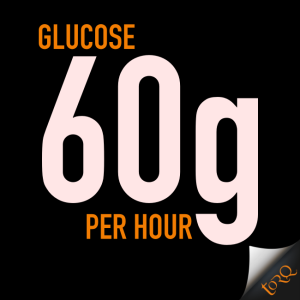
The Intestinal Transporters SGLT-1 & GLUT-5
Following on from the study by Jeukendrup & Jentjens, 2004 became another year for ground-breaking findings. The answer as to why endurance athletes were developing gastric upset by fuelling excessively on glucose (above 60g/hr) was answered. Jentjens and colleagues (2004) suggested that sitting within the intestinal walls are carbohydrate transport proteins or to use the analogy, carbohydrate shuttle busses that transport different carbohydrates from the intestine to the blood. The intestinal transport protein responsible for glucose absorption is called SGLT-1 and becomes completely saturated at 60g/hr. If consumption exceeds this threshold, additional carbohydrate remains in the intestine, increasing the potential for gastric discomfort as the residual is unable to be absorbed. Jentjens et al also discovered at this time that fructose in fact used a separate transport protein to get into the blood called GLUT-5 and interestingly the transport of fructose was found to be completely independent to the transport of glucose. This breakthrough in understanding meant that both glucose and fructose could be mixed together in a solution and they would not compete with each other for absorption, resulting in a higher overall carbohydrate delivery. Since then, when referring to combined glucose and fructose mixes, they became known as ‘multi-transportable carbohydrate formulations.’
In these studies, only one of the carbohydrate drink formulations increased carbohydrate oxidation and that was the Glucose:Fructose formulation. When fructose was ingested alongside glucose at a rate of 0.6g/min (36g/hr), exogenous carbohydrate oxidation from the drink increased by around 50%.
The video below highlights the process explained above based on a 2:1 Glucose:Fructose formulation, the ratio that has been heavily researched and used extensively throughout TORQ’s fuelling range:

Why Do Carbohydrate Ratios Exist?
Since 2005, research has explored various carbohydrate ratios of multi-transportable carbohydrates in detail with the main topic areas considering exogenous carbohydrate oxidation rates (the amount of carbohydrate you consume that actually gets converted into energy), gastric comfort, and of course exercise performance. There is now a mountain of peer-reviewed published studies supporting 2:1 Glucose:Fructose formulations (studies listed under ‘references’ on our product tabs) in their ability to deliver 90g of carbohydrate per hour, enhancing endurance performance by affording the athlete a higher pace and extending time to exhaustion. As we explained earlier, endurance events are becoming increasingly more challenging and the demand for carbohydrate fuel is increasing. 60g of carbohydrate is simply not enough fuel to maximise performance in racing and long training sessions, especially when others are consuming 90g per hour using multiple-transportable carbohydrate products. The additional 30g of usable exogenous carbohydrate per hour is highly significant – it’s an additional 30g per hour of carbohydrate that would otherwise be burned from your limited endogenous stores.
Why Has The Research Settled On 2:1?
This ratio maximises, but does not exceed, the body’s glucose absorption threshold by fully saturating SGLT-1 at the known capacity of 60g/hr or 1g/min. The remaining 30g/hr of carbohydrate fuel will come from the fructose component at a rate of 0.5g/min. Total carbohydrate delivered = 90g/hr.
What’s important to note when looking at ratios between these carbohydrates is that to optimise multiple transportable carbohydrate absorption, the glucose transporter SGLT-1 must be as close to saturation as possible before the benefits of fructose can be fully realised. There are 2 reasons for this:
1. Glucose is the preferred fuel source for exercise, because once in the blood, it is immediately available for processing by the muscles whereas fructose has to take a longer pathway via the liver before it is converted into glucose. Therefore ensuring glucose absorption is at saturation point maximises the availability of immediately useable fuel.
2. Research by Rowlands et al (2015) suggests that it is the saturation of the SGLT-1 transporter by glucose that drives greater fructose absorption – something they refer to as an absorption gradient. This isn’t to say that fructose isn’t absorbed when SGLT-1 isn’t saturated, but it suggests that in order to drive higher total levels of carbohydrate uptake, saturation of SGLT-1 becomes necessary.
In essence, what we’re saying here is that if total carbohydrate intake from a 2:1 formulation equals 60g/hr, this will represent just 15g per hour delivered via fructose and both glucose and fructose will be absorbed easily. At 60g/hr however, arguably there would be no benefit from a 2:1 formulation over one containing 100% glucose. The benefits from a 2:1 formulation start to be realised beyond a 60g/hr total carbohydrate intake and this is what the large body of research has proven. As carbohydrate intake is ramped up to 90g, the SGLT-1 transporters become more and more saturated, driving fructose uptake. 60g/hr of glucose and 30g/hr of fructose has been proven to work exceptionally well.
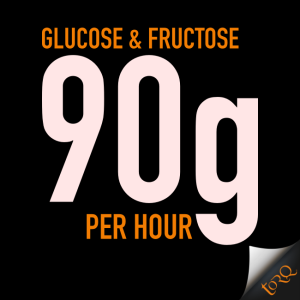
How About 1:0.8 Glucose:Fructose?
We have recently seen the emergence of sports nutrition products boasting a new multi-transportable carbohydrate ratio of 1:0.8 Glucose:Fructose. The reality is that this research is anything but new and is now nearly a decade old (2013) and if we had seen further developments in this area over the last 10 years it would perhaps have given us a little more to talk about. Nothing appears to have prompted scientists to look into the concept any further until very recently (May 2022) when finally another study has been published. We look at both studies here.
The research from O’Brian et al., (2013) explored the effect of ingesting 108g of carbohydrate per hour in the form of a 1:0.8 carbohydrate ratio. This formulation works out to be 60g from glucose and 48g from fructose per hour. The results from this study did show that the oxidation rate of carbohydrate was higher than at the 2:1 ratio when 108g/hr of carbohydrate was consumed, but the results weren’t considered statistically significant. Gut comfort was also measured and there was little to no difference between any of the carbohydrate formulations tested.

If we break down the composition of the formula used within this study, it supports the scientific justification we have discussed throughout this article – saturating the glucose transporter at 60g per hour with the additional carbohydrate coming from fructose, yet ironically this is also where the 1:0.8 formulation falls apart. This formulation only becomes ‘optimal’ (if you’re to ignore the lack of statistical significance in the results) at the very specific target ingestion of 108g/hr and even then the data suggests that there could be fructose sitting around unabsorbed in the gastric tract due to the Glut-5 transporters being overly saturated. The subjects in this study were tested over only a 2-hour period, so we would question what would happen to their digestive systems if fructose were to ‘back up’ in their GI tract over say 3 or 4 hours? What would happen if the endurance event lasted longer than this and 108g or more of 1:08 ratio carbohydrate was taken onboard hour after hour? It seems that if improvements in uptake did occur, this was probably due to over saturation of the GLUT-5 transporters with fructose and the danger is that by achieving this, not all of it may have been absorbed. Fine perhaps for 1 or 2 hours of exercise, but a questionable fuelling approach for longer efforts?
The largest issue with a formulation at this ratio is that at less than 108g per hour, SGLT-1, the glucose transporter in the gut isn’t saturated, yet there are very high levels of fructose being delivered to the gut. The risk is that if intakes are backed off from the optimal 108g/hr, SGLT-1 is no longer saturated and the absorption gradient for fructose diminishes. This represents a precarious fuelling strategy that sees the athlete needing to consistently take on board very high levels of fuel for the strategy to work and real life just isn’t like that. As overall carbohydrate intakes drop, the science would suggest that more and more fructose would back up in the gut which you’d expect to cause discomfort as well as the formulation being far from optimal in delivering the high levels of carbohydrate it was intended to do.
As an example, at 80g of total carbohydrate per hour, a 1:0.8 ratio would deliver 44g of glucose and 35g of fructose. By comparison, a 2:1 ratio would deliver 53g of glucose and 26g of fructose. At this level of fuelling, the 2:1 formulation offers 2 very clear advantages, less overall fructose and higher saturation of SGLT-1 to drive fructose absorption. This logic is applicable to every carbohydrate ingestion rate under 108g of carbohydrate ingestion per hour, meaning that a 2:1 ratio would offer a higher % of glucose and therefore greater delivery of carbohydrate to the muscle than a 1:0.8 formulation. Essentially then, unless the SGLT-1 transporter is saturated with glucose, high levels of fructose are not a good thing. This is why the ratio between glucose and fructose is so vitally important.
Perhaps most significantly, a recent study by Podlogar and colleagues (May 2022) looked at oxidation rates and fuel utilisation (from carbohydrates and fats) whilst comparing the consumption of 120g/hr of a 1:0.8 Maltodextrin:Fructose formulation with 90g/hr of a 2:1 Maltodextrin:Fructose formulation. It’s worth bearing in mind that this is very new research and it has been published quite a while after a number of brands have already gone to the market with their 1:0.8 formulations based on the findings of the single study from O’Brien et al (2013).
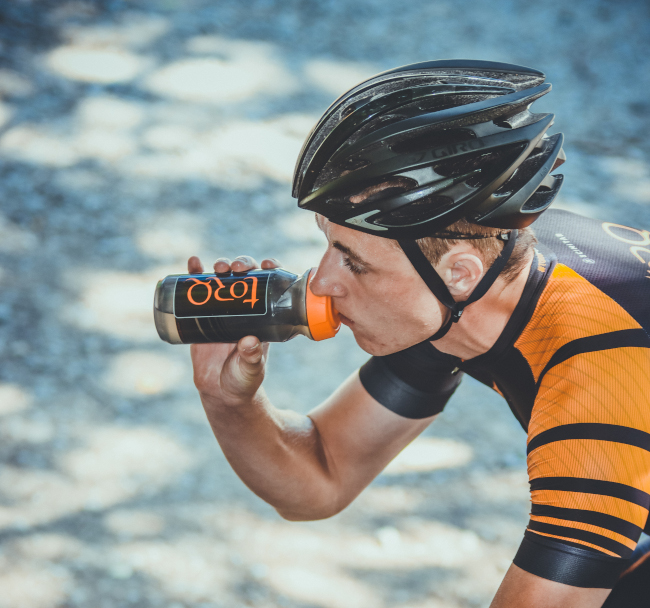
This new study found that whilst carbohydrate oxidation rates were higher in the 1:0.8 group, consistent with the 2013 study, fat utilisation dropped and was higher in the 2:1 group. This is highly significant and meant that the 1:0.8 group simply switched from fat to enhanced carbohydrate metabolism whilst receiving no performance advantage. During endurance exercise, both fats and carbohydrates are burned as fuels. Notably, fat is held in a practically limitless supply within the human body, so there is no logic to following a carbohydrate fuelling strategy that forces the body to burn less of this abundant fuel. Furthermore, the study concluded that the 1:0.8 group didn’t benefit from any carbohydrate-sparing effect and this was despite the 1:0.8 group consuming 30g more carbohydrate per hour. This again would have been directly as a result of the 1:0.8 group switching to burning less fat.
The take home message here is that there was no performance advantage or time to exhaustion advantage achieved by consuming 120g/hr from a 1:0.8 formulation over consuming 90g per hour from a 2:1 formulation. In addition, the researchers noted that both stomach fullness and feelings of nausea were higher in the 1:0.8 group, which is consistent with our discussion above about fructose potentially backing-up in the gut, which would be highly likely to cause issues during longer events.
When considering these studies, we view your choice as simple. Achieve exactly the same performance and carbohydrate-sparing benefits by either consuming 90g/hr of a 2:1 formulation or 108g-120g/hr of a 1:0.8 formulation. Bear in mind that with a 1:0.8 formulation, you could risk gastro-intestinal issues during longer events due to the high carbohydrate intake levels and the fructose not being fully absorbed. Also consider that even during shorter events, failure to maintain the high carbohydrate intakes of 108g-120g/hr could cause even more concerning digestive issues.
When given the option of being able to consume less carbohydrate for the same performance benefits, surely it’s not a difficult decision to make? When that decision carries with it much less concern about stomach/gastro-intestinal discomfort and the ability to be flexible with the volume of your fuelling intake, hopefully it becomes crystal clear why using a 2:1 formulation would appear to be superior in every way.
120g Per Hour @ 2:1 Ratio?
The afore mentioned study by Podlegar pretty much puts the final nail in the coffin with regard to any suggested performance advantages of 1:0.8 over 2:1 formulations, but even that study didn’t compare like with like (120g/hr versus 90g/hr). It clearly showed that gram for gram of carbohydrate ingested, a 2:1 formulation was superior. So, what happens if you push your intake of a 2:1 formulation to 120g of carbohydrate per hour?
A study by Virbay and colleagues (2020) demonstrated that 120g/hr of carbohydrate was achievable via a 2:1 ratio formulation and we talk about it in this article when the news broke. The research highlighted that mountain marathon runners absorbed a very high dose (120g/hr) of carbohydrate from a 2:1 Glucose:Fructose formulation, exactly the same carbohydrate formulation found within TORQ’s Fuelling System product range, and experienced little to no gastric upset in a real life race-paced mountain marathon event.
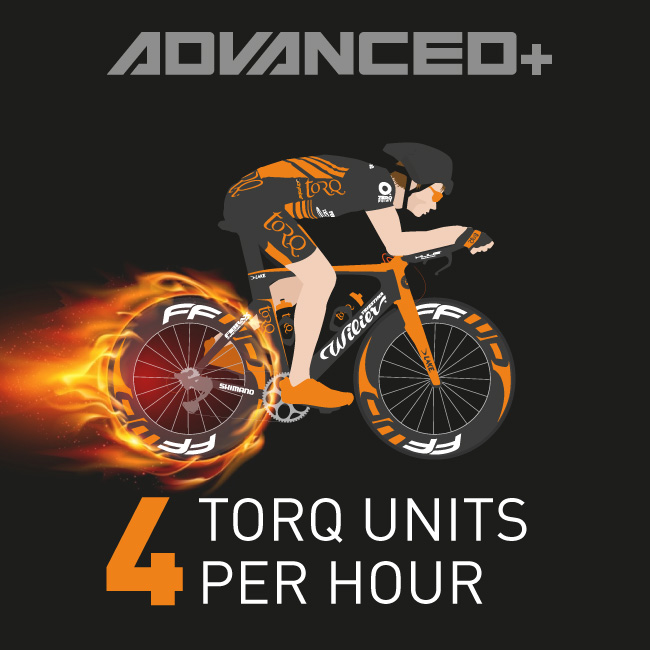
Prior to this event, all 26 elite/professional mountain marathon runners completed a 3 week bout of nutritional training, where the athletes would complete their weekly training commitments. During this time they added progression by increasing the amount of carbohydrate consumed within each training session until they found themselves comfortable at ingesting 120g of carbohydrate per hour (4 TORQ units per hour). The results demonstrated that during the event, the athletes that consumed 120g/hr found the event significantly easier, statistically compared to those fuelling on 90g/hr and 60g/hr respectively. Another key finding was that biochemical markers of muscle damage in the 120g/hr group were significantly lower than groups consuming 60 – 90g/hr. This highlights that muscle fatigue is likely to have been reduced, offering stronger potential for exercise performance to be maintained during long duration events, but also holds significance for races where limited periods of recovery are key to the race outcome, such as multi-day stage racing.
This study also demonstrates the importance of gut-training, which we discuss towards the end of this article and have specifically written about it in our Training The Digestive System article.
Fuelling Flexibility
Fuelling optimally also extends further than implying ingesting the correct amount of carbohydrate. We have to remember that when we consume a fuelling product, it may often be in the heat of battle and so it is important to remember that we are working with real life scenarios, rather than exercising in highly controlled lab conditions.
It is also worth considering the types of products you like to consume, the flavours you like to experience during exercise and how the environment may influence your nutritional approach. You can have the world’s best product but if it doesn’t taste nice, are you really going to want to consume it multiple times per hour – hour after hour?
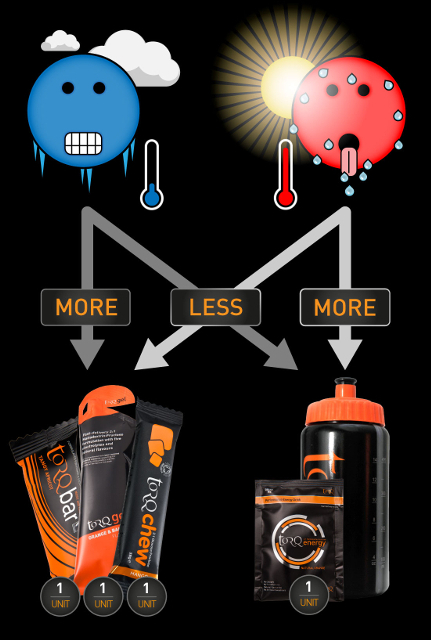
We have worked tirelessly over the years to build a scientifically robust, but equally flexible Fuelling System which allows you to consume your fuelling nutrition in 30g units across our full range of fuelling products (we have 4 fuelling products with 4 different textures and 24 flavours in total). With this variety of product, all delivering 30g of multiple-transportable carbohydrates, it really is down to you to choose how you take on board your fuel and how much. We recommend 30g (1 TORQ Unit) per hour for leisure, 60g (2 TORQ Units) per hour for general fuelling, because it takes a minimal amount of focus effort and provides strong results, 90g (3 TORQ Units) per hour for advanced fuelling for competition and based on the research by Virbay et al (2020), 120g (4 TORQ Units) per hour could be possible with some attention paid to training the gut, which is the final area we are going to talk about in this article (below). The TORQ Fuelling System also adapts to your Hydration needs encouraging you to drink more 30g fuelling units when perspiration rates are high and consume more of the concentrated fuelling units when dehydration is less of a concern. In most cases, fuelling involves a mix of drinks and concentrated fuelling units.
Please watch the short video below, which explains how the TORQ Fuelling System works or click HERE to read about it:

Training The Gut
Finally, this is an area of research that is of particular interest to us moving forward, because the scientific consensus certainly seems to be that the gut is a trainable organ and the ability of a person to absorb carbohydrate is to some extent linked to how conditioned their digestive system is. At the elite end of the spectrum, this is a serious consideration, because it may be that with practice, larger amounts of carbohydrate could be processed than were originally thought possible.
For instance, we referred above to a recent study by Virbay et al (2000) and covered this in an article last year entitled The Best Just Got Better where the research demonstrated that elite athletes were able to consume 120g of carbohydrate per hour using a 2:1 glucose:fructose ratio product like TORQ. The athletes undertook 3 weeks of high carbohydrate nutritional training, gradually increasing the amount of carbohydrate they consumed within each training session until they were comfortable consuming 120g/hr from a 2:1 carbohydrate ratio. This is an area of research we are very excited about and suggests that fuelling at 120g/hr with a 2:1 ratio could certainly be possible if some specific gut-training techniques are employed, so we will be keeping a very close eye on the developments within this area. Perhaps this research turns on its head the notion that 60g/hr of glucose ingestion is the limit – through training the gut, could more be ingested? The same logic could be argued for training the Glut-5 transporters for increased fructose absorption?
Further research is also needed as to whether the extra carbohydrate that’s absorbed and burned at these very high intake levels is actually useful? As we discussed earlier, the most recent research into 1:0.8 ratios of Glucose:Fructose suggest that although more carbohydrate is burned at these high intakes, all it does is down-regulate fat metabolism, so the athlete receives no fuelling advantage. Research may confirm in the future that 90g/hr is in fact the upper performance limit and there is no benefit to exceeding it?
For further information on training the digestive system, click HERE to read our comprehensive article on the subject.
Summary
Since 2005, study after study has supported a ratio of 2:1 Glucose:Fructose in successfully delivering 90g of carbohydrate per hour to the working muscles of a wide variety of test subjects with differing athletic statuses. A recent study suggest that with some training of the gut, elite performers may be able to utilise as much as 120g of carbohydrate per hour using a 2:1 formulation.
One study from 2013 looking at a 1:0.8 formulation could suggest a slight benefit over a 2:1 formulation at the very specific hourly dose of 108g/hr, although any suggested improvements were not found to be statistically significant and subjects were only exercising for 2 hours. Also, fuelling with products at this ratio below 108g per hour would offer diminishing benefits compared to a 2:1 ratio as well as the increased risk of stomach upset.
Most significantly, a recent study from 2022 has proven that no performance or carbohydrate-sparing advantage was gained from consuming 120g of carbohydrate per hour at a 1:0.8 ratio compared with 90g/hr with a 2:1 formulation. The study demonstrated that any extra oxidation of carbohydrate from the 1:0.8 formulation was at the expense of fat oxidation, therefore providing no performance benefit. The 1:0.8 group also experienced heightened feelings of bloating and nausea when compared to the 2:1 group.
We cannot advocate that an athlete goes to the trouble of consuming very high levels of carbohydrate when there are no palpable benefits and gastric comfort is compromised. Also, we couldn’t recommend a formulation that could cause heightened gastric issues if taken in lower doses. Furthermore, when a 2020 study has proven performance benefits in elite athletes consuming very high levels (120g/hr) of a 2:1 formulation and we know that a mountain of peer-reviewed published research supports the use of 2:1 formulations at lower intake levels too, we clearly have no option but to endorse this formulation.
Without further research and many more studies addressing the 1:0.8 ratio, we don’t feel there is sufficient evidence to recommend using this formulation. We would go as far as to say that there’s sufficient evidence from these studies to suggest that there are distinct disadvantages of using a 1:0.8 formulation.
As new research lands, you can be assured that we will review it thoroughly here at TORQ and if we need to adjust our formulations in the future in order to maintain their optimal function, we will do it. As it stands, we haven’t seen any evidence in almost 20 years that would lead us to make this decision. The evidence supports a 2:1 formulation in being able to offer successful fuelling within a range of 30g to 120g of carbohydrate per hour and we still continue to recommend an optimal fuelling range of 2-3 TORQ Units per hour, or 60-90g per hour. We hope that an increasing amount of research will become available that looks at training the gut and whether with conditioning the SGLT-1 and GLUT-5 transporters can be trained to function to a higher level. We will also remain open minded as to whether other more optimal ratios of glucose:fructose may exist.
Next time you reach into your jersey pocket, run vest, or kit bag and pull out a TORQ product, you will understand why we take a significant amount of time to analyse the research so that you can maximise your training and racing experience.
If you have any further questions about this article or any other on this website, please don’t hesitate in contacting us on 0344 332 0852 or by email on enquiries@torqfitness.co.uk
If you would like further information about TORQ’s Fuelling System products or would like to purchase, please click HERE.
References
Jentjens, R.L. and Jeukendrup, A.E., 2005. High rates of exogenous carbohydrate oxidation from a mixture of glucose and fructose ingested during prolonged cycling exercise. British Journal of Nutrition, 93(4), pp.485-492.
Cermak, N.M. and van Loon, L.J., 2013. The use of carbohydrates during exercise as an ergogenic aid. Sports Medicine, 43(11), pp.1139-1155.
Viribay, A., Arribalzaga, S., Mielgo-Ayuso, J., Castañeda-Babarro, A., Seco-Calvo, J. and Urdampilleta, A., 2020. Effects of 120 g/h of Carbohydrates Intake during a Mountain Marathon on Exercise-Induced Muscle Damage in Elite Runners.Nutrients, 12(5), p.1367.
Jeukendrup, A.E. and Jentjens, R., 2000. Oxidation of carbohydrate feedings during prolonged exercise. Sports medicine, 29(6), pp.407-424.
Gollnick, P.D., Piehl, K. and Saltin, B., 1974. Selective glycogen depletion pattern in human muscle fibres after exercise of varying intensity and at varying pedalling rates. The Journal of physiology, 241(1), pp.45-57.
Jentjens, R.L., Moseley, L., Waring, R.H., Harding, L.K. and Jeukendrup, A.E., 2004. Oxidation of combined ingestion of glucose and fructose during exercise. Journal of Applied Physiology.
Jentjens, R.L., Venables, M.C. and Jeukendrup, A.E., 2004. Oxidation of exogenous glucose, sucrose, and maltose during prolonged cycling exercise. Journal of Applied Physiology, 96(4), pp.1285-1291.
Rowlands, D.S., Houltham, S., Musa-Veloso, K., Brown, F., Paulionis, L. and Bailey, D., 2015. Fructose–glucose composite carbohydrates and endurance performance: Critical review and future perspectives. Sports Medicine, 45(11), pp.1561-1576.
O’Brien, W.J., Stannard, S.R., Clarke, J.A. and Rowlands, D.S., 2013. Fructose-maltodextrin ratio governs exogenous and other cho oxidation and performance. Med Sci Sports Exerc, 45(9), pp.1814-24.
O’Brien, W.J. and Rowlands, D.S., 2011. Fructose-maltodextrin ratio in a carbohydrate-electrolyte solution differentially affects exogenous carbohydrate oxidation rate, gut comfort, and performance. American Journal of Physiology-Gastrointestinal and Liver Physiology, 300(1), pp.G181-G189.
Podlogar, T., Bokal, Š., Cirnski, S. and Wallis, G.A., 2022. Increased exogenous but unaltered endogenous carbohydrate oxidation with combined fructose-maltodextrin ingested at 120 g h− 1 versus 90 g h− 1 at different ratios. European Journal of Applied Physiology, 122(11), pp.2393-2401.
Horowitz, J.F., Mora-Rodriguez, R., Byerley, L.O. and Coyle, E.F., 1997. Lipolytic suppression following carbohydrate ingestion limits fat oxidation during exercise. American Journal of Physiology-Endocrinology And Metabolism. E768-E775
Watt, M.J., Krustrup, P., Secher, N.H., Saltin, B., Pedersen, B.K. and Febbraio, M.A., 2004. Glucose ingestion blunts hormone-sensitive lipase activity in contracting human skeletal muscle. American Journal of Physiology-Endocrinology and Metabolism, 286(1), pp.E144-E150.







